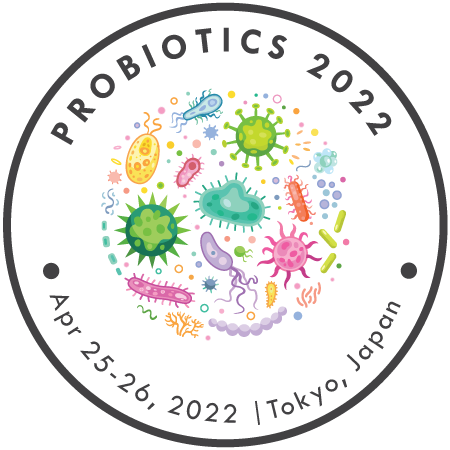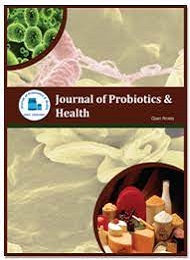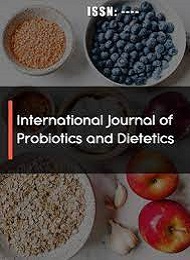Theme: “Better Health Better Worldâ€
Probiotics 2022
Conference Series LLC Ltd morning and offers all the funders from over the world to attend “12th International Conference on Probiotics and Prebiotics” during April 25-26, 2022 Tokyo, Japan which includes prompt keynote presentations, Oral talks, Poster presentations and Exhibitions. The congressional board is gearing up for an exciting and educational conference which include important presentations, unlimited lectures, young research forum, conferences and oral talks on knowledge topics, E-poster presentations and various program for members from all over the globe.

We heartily request participants to take part in 12th International Conference on Probiotics and Prebiotics, to share expressive experience from researchers around the world. PROBIOTICS 2022 on behalf of its organizing Committee welcomes all the prominent researchers, students, nutritionists, industrial experts, food technicians, healthcare specialist and delegates to participate in our upcoming Probiotics 2020 to witness valuable scientific talks and discussions and contribute to the future innovative ideas and technologies about Probiotics, Functional food and Nutraceuticals.
The theme of the conference “Better Health Better World”
Download Broucher https://probioticsfood.foodtechconferences.com/conference-brochure.php
Probiotics 2022 mainly focus on Probiotics, Nutritional supplements, Health & Dietary issues across the globe. It is related to every aspect of Nutrition, Food Science, Health & Dietary research which provides new opportunities for specialists of all over the world to meet, exchange, organize and explore new technologies and research ideas. We invite all Probiotics 2022 is an international conference where the various probiotics, nutraceuticals, nutrition related concept was discussed on single platform. Probiotics 2022 goal is to broadcast and exchange knowledge in Probiotics, Nutraceuticals and Functional Food importance in the life. Therefore, a perfect platform to gain knowledge about gut health and nutrition.
Target Audience
- Food scientists
- Young Research Fellows
- Nutritionist
- FMGC
- Healthcare professionals
- Business professionals
- Physicians
- Policymakers
- Food industry
- Students
- Microbiologists
- Institution Heads
Track1 Preterm and term Newborns Probiotics
Very preterm newborn children are at higher risk of late onset sepsis and necrotizing enterocolitis (NEC), with the related potential for long lasting unfriendly wellbeing impacts or demise. Preterm babies have an alternate gut microbiota than term infants, including decreased species variety, higher quantities of Enterobacteriaceae (including Klebsiella pneumoniae and Escherichia coli) and Clostridium difficile, and diminished quantities of Bifidobacteria and Lactobacilli. These differences might be a consequence of host factors related with immaturity, environmental factor, exposure to antibiotic treatment, less breastfeeding, and prolonged stays in neonatal intensive care units.
Track2 Prebiotics old and new
The prebiotics concept was introduced for
The basic criteria for selection of prebiotics are
-
Resistance to digestion
-
Hydrolysis and fermentation by colon microflora
-
Selective stimulation of growth of one or limited number of bacteria
-
Beneficial health effects to the host.
Track 3 Microbiome
The microbiome consists of microbes that are both beneficial as well as potentially harmful. In a healthy body, pathogenic and symbiotic microbiota coexists. But if there is any disturbance in that balance due to infection, diet and antibiotics, body become more susceptible to diseases.
Microbiota stimulates the immune system and breakdown potentially toxic food compounds and synthesizes certain vitamins and amino acids, including the B vitamins and vitamin K. The microbiota of a healthy person will also provide protection from pathogenic organisms that enter the body such as through drinking or eating contaminated water or food.
Prebiotics feed our beneficial microbiota. Although there are supplements containing prebiotic fibers, many healthy foods naturally contain prebiotics. The highest amounts are found in raw garlic, onions, leeks, asparagus, Jerusalem artichokes, dandelion greens, bananas, and seaweed.
Track 4 Formulations and Production
For successful delivery of probiotic benefits to the consumer, several criteria must be met. For manufacturing, an intricate production process is required that ensures both high yield and stability and must also be able to meet requirements such as the absence of specific allergens, which require some obvious culture media ingredients. Reproducibility is important to ensure constant high performance and quality. To ensure this, quality control throughout the whole production process, from raw materials to the final product, is essential, as is the documentation of this quality control. Consumer product formulation requires skill and experience to formulate the final product.
Track 5 Microbiota from womb to adult
Normal microbiota changes during pregnancy including increases in oral presence of Porphyromonas gingivalis, Aggregatibacter actinomycetemcomitans, and Candida, Actinobacteria, Proteobacteria in gastrointestinal tract. Probiotic consumption of Lactobacillus rhamnosus and Bifidobacterium lactis in pregnant women with metabolic disorder decreased fasting blood glucose, improved glucose tolerance, and decreased the frequency of gestational diabetes mellitus. Probiotics able to enhance the immunosuppressive environment of the uterus either through direct colonization of the placenta and amniotic fluid, or by a peripheral interaction.
Maternally administered probiotics may impact the health of a newborn by altering the bacteria that initially colonize the developing infant. Maternal probiotics thus have the potential to influence neonatal immune development as the initial development of the immune system is dependent on the gut microbiota.
Track 6 New Methods and New Equipment
Prebiotics are food component that stimulate the growth of beneficial bacteria in the gut, they are living bacteria that pass through the upper gastrointestinal tract and colonize the colon. Some studies showed that many commercial probiotic products are ineffective as they do not survive in the process of Food processing, storage and passage through the GIT. So, effective strategies are needed to improve the stability of probiotics in food and their passage through GIT.
Microencapsulation has been an effective approach that protects probiotics from degradation. Effective microencapsulation system maintains the stability of the probiotics during storage and protects them from unfavorable condition of GIT.
Microencapsulation technique include
-
Simple microgels
-
Core shell microgels
-
Bioploymer complex microgels
-
Gastric resistant microgels
-
Nutrient doped microgels
Coating technologies can also use to improve the viability of probiotics in food products and GIT. In this probiotics are coated with a layer of material. Coating technologies are suitable for increasing mucoadhesion of probiotics. Strong mucoadhesion enables probiotics to adhere to the intestinal mucosa after their release in the colon.
Track7 Nutrition and Probiotics
There are many probiotic rich foods are present naturally which provides benefit to the body. Probiotic are healthy bacteria that help in detoxification, defend the line of intestine, increase bioavailability of nutrients and protect against infectious microorganisms. Most common probiotic foods include
-
Yogurt
-
Kefir
-
Sauerkraut
-
Kimchi
-
Tempeh
Track8 Pre and Probiotics futures
From the past several decades the research into the field increased tremendously.
Genetic characterization and modification of strains, state-of-the-art in vitro, in vivo, and in silica techniques are driving probiotic and prebiotic research to uncover the effects of probiotics and prebiotics on their targets, and methods to identify main molecules that mediate host benefits. Young scientist need to acquire scientific data and tools and network each other to perform experiments and new researches in the field.
Track 9 Prebiotics and Diet
Prebiotics play an important role in human health. Prebiotics feed the intestinal microbiota and their degradation products are short chain fatty acids released into the blood circulation.
-
Chicory root have high inulin helps in digestion and provides antioxidant properties.
-
Garlic promotes growth of gut bacteria.
-
Bananas are beneficial and provide natural fiber.
-
Barley is an immune boosting, antioxidant and prebiotic fiber source.
Track 10 Probiotics in food security
Food security exists when all people, at all times, have physical and economic access to sufficient, safe and nutritious food that meets their dietary needs and food preference for an active and healthy life. The process of food fermentation plays a crucial role in providing food security, enhancing livelihoods and improving the nutrition and social wellbeing of millions of people around the world, particularly the marginalized and vulnerable.
Advantages of probiotic include
-
Diminishing undesirable elements of raw product.
-
Improving food digestibility and nutrient availability
-
Enrichment of food with vitamins and amino acids.
-
Reducing cooking time
-
Improve in shelf life
Track 11 Pediatric and Infant Health
Probiotic and prebiotic is a hot topic in pediatrics research. According to various studies human milk enhances the development of bifidogenic microbiome in infants. The use of probiotics among very low-birth-weight infants is constantly increasing, as it is believed that probiotics help in reducing the incidence of severe diseases, such as necrotizing enterocolitis (NEC) and late-onset sepsis and improve feeding tolerance.
Track12 Food and Fermentation
Fermented foods are produced through controlled microbial growth and conversion of food components through enzymatic action. There is a surge in demand of such food products due to their health benefits. Some fermented foods include
-
Kefir
-
Sauerkraut
-
Tempeh
-
Kimchi
Track13 Synbiotic
A synbiotic is described as a "mixture of probiotics and prebiotics that improves the survival and activity of beneficial microorganisms in the gut by beneficially affecting the host." Synbiotics are those products in which the prebiotic compound selectively favors the synthesis and metabolite formation of probiotics
Track14 Microbiota Protection and Resilience
The human gut harbors trillions of microbes this microbial ecosystem plays a crucial role in human physiology and health. Resilience is the property of an ecosystem to resist changes under stress or to quickly and fully recover from the perturbations. Many studies have shown that dietary fibers impact the composition and function of the microbiota.
Increased dietary fiber intake increases the diversity of the human gut microbiota and diversity may be a positive contributor to resilience.
Track15 Probiotics in Aquaculture
Aquaculture is the world’s fastest-growing sector. Initially, probiotics were used for disease control, now they are used for improving fish growth and reproduction. Probiotics acts as a nutrient source provide enzymes for better digestion and increase the immune response against pathogenic bacteria. In this adequate amount of microbes are fed to the organism to modify the gut microflora which replaces harmful microbes with beneficial ones. By populating the gut, these exogenous microorganisms rival microbes, preventing their attachment to the intestinal wall, restricted admittance to supplements, and discharging antibacterial substances, for example, bacteriocins and natural acids. Regarding advancing development, the expansion of amicable microorganisms increases stomach-related chemicals, like proteases, amylases, and lipases, in the gut promoting improved digestion and supplement usage.
Track16 Probiotics in women’s health
The human probiotics market size is anticipated to surpass USD 5 billion by 2024 owing to its increasing demand. Probiotics are used to treat Urinary tract infections, diabetes, diarrhea, vulvovaginal candidiasis, and bacterial vaginosis in women. Several in vitro and in vivo studies support the beneficial effect of some strains of lactobacilli on the restoration of the vaginal flora and the prevention of recurrent UTIs.
Track 17 Probiotics in oral health and dentistry
The common probiotic strains of Lactobacillus and Bifidobacterium genera administered in different forms (lozenge, tablets, powders, gums) beverages(milk, yogurts, juices), foods(cheese, kefir, ice cream) The use of these products with probiotics demonstrated good results as an auxiliary method on the prevention and treatment of oral dysbiosis due to their direct and indirect effects against the pathogenic oral microorganisms growth and immunomodulation.
Track 18 Probiotics and COVID-19
Probiotics boost the immune system, enhance the mucosal barrier function and inhibit bacterial adherence and invasion capacity in the intestinal epithelium by being in a direct antagonism with pathogenic bacteria. The gut-lung axis is involved in the pathogenicity of bacterial and viral infections, as the intestinal microbiota boosts the alveolar macrophage activity, thus having a protective role in host defense against pneumonia. Along these lines, current clinical evidence connects gut, lung, and brain as an entity with communication mediated through complex neural, immunologic inflammatory, and neuroendocrine networks, the so called gut-brain-lung axis. There are indications in animals and humans that intestinal microbiota provides bacteria to the lungs, as abundance of Bacteroides sp. is observed in the lung following sepsis. Moreover, following sepsis, neurologic and cognitive outcomes are observed. Without any doubt, the importance of the gut microbiome is stated. The composition of the gut microbiome may be used as a predictive tool of disease development and infection severity.
Track 19 Gut Bacteria on COVID Severity
Coronavirus disease 2019 (COVID-19) has affected millions of lives globally. However, the disease has presented more extreme challenges for developing countries that are experiencing economic crises. Studies on COVID-19 symptoms and gut health are scarce and have not fully analyzed possible associations between gut health and disease pathophysiology. Therefore, this study aimed to demonstrate a potential association between gut health and COVID-19 severity in the Lebanese community, which has been experiencing a severe economic crisis.
Probiotics are useful microbes which usually found inside healthy human gut. Probiotic microbes experience many reticulated mechanisms to push proper health at the molecular level. They overcome harmful microorganisms within the gut and reduce risk of infections and diseases by enhancing the immune response. Probiotic food incorporates Yogurt, Kefir, Sauerkraut, Miso, Kampuchea, Pickles etc. The probiotics market is measurable to be esteemed at 45.64 Billion of every 2019, and is anticipated to prevail in a cost of USD 64.02 Billion by 2022, at a CAGR of 7.0% from 2019. The market is driven by factors like developing awareness with respect to health advantages of yogurt among customers, rising interest for supplement rich encourage for animals, and expanding nature of probiotic dietary supplements. Current Researchers in Singapore have fermented up a brew containing probiotic microbes that can enhance gut wellbeing and enhance the immune system in August 14, 2019.
According to the report, global human microbiome market was valued at approximately USD 721.63 million in 2017 and is expected to generate revenue of around USD 1,365.49 million by the end of 2024, developing at a CAGR of around 9.40% among 2018 and 2024.
Probiotics Market is expected to garner $57.4 billion by 2022, registering a CAGR of 7.7% during the forecast period 2016-2022. Probiotics are microorganisms, such as bacteria and yeast that benefit humans and animals by maintaining intestinal microbial balance.
The Global Bio stimulant Market was valued at $1,784 million in 2016, and is projected to reach $4,089 million by 2023, growing at a CAGR of 12.6% from 2017 to 2023. Bio stimulants are biologically produced fertilizers that are used to stimulate plant improvement and productivity, in addition to the nourishment of agrarian products.
Conference Highlights
- Gut microbiota
- Preterm and term Newborns Probiotics
- Prebiotics old and new
- Microbiome
- Formulations and Production
- Microbiota from womb to adult
- New Methods and New Equipment
- Nutrition and Probiotics
- Pre and Probiotics futures
- Prebiotics and Diet
- Probiotics in food security
- Pediatric and Infant Health
- Food and Fermentation
- Synbiotic
- Microbiota Protection and Resilience
- Probiotics in Aquaculture
- Probiotics in women’s health
- Probiotics in oral health and dentistry
- Gut Bacteria on COVID Severity
- Probiotics and COVID-19
To share your views and research, please click here to register for the Conference.
To Collaborate Scientific Professionals around the World
| Conference Date | April 25-26, 2022 | ||
| Sponsors & Exhibitors |
|
||
| Speaker Opportunity Closed | |||
| Poster Opportunity Closed | Click Here to View | ||
Useful Links
Special Issues
All accepted abstracts will be published in respective Our International Journals.
Abstracts will be provided with Digital Object Identifier by






